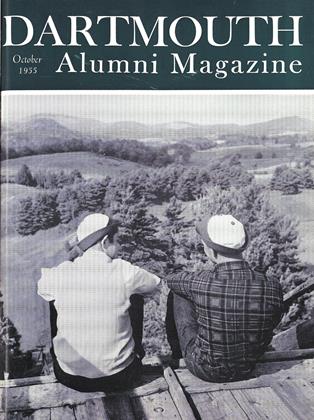DARTMOUTH COLLEGE physicists are putting the finishing touches on a 150,000-volt nuclear accelerator that will begin operating this month in the north wing of Wilder Physics Laboratory. It will be used to produce radioactive isotopes for undergraduate teaching and faculty research.
Construction of the accelerator, specifically a "deuteron" accelerator because it shoots the nuclei of deuterium or heavy hydrogen atoms, is a milestone in physics at Dartmouth. It is one of only two or three in the nation specifically designed to be used by undergraduates in their laboratory sessions.
By bombarding targets of deuterium or tritium, both isotopes of hydrogen, with the nuclei of heavy hydrogen atoms, the physicists will produce atomic "fusion" on a small, controlled scale.
Neutrons with energies up to 14,000,000 electron volts will be released, depending on the target material against which the hydrogen nuclei are fired. Other substances can be made radioactive by exposing them to this flux of high energy neutrons.
The accelerator was designed and built by Prof. Willis M. Rayton, now on leave as Visiting Research Professor at the University of Alaska, and Prof. Leonard M. Rieser Jr. '44, who was an atomic scientist during World War II both at the University of Chicago and at Los Alamos.
Built entirely with departmental funds, in itself an engineering feat of a high order, the accelerator will be used to study the scattering and absorption of neutrons by various materials. It will produce radioactive isotopes for experimentation by students, even in the introductory course in physics.
A sample of this is the study of radioactive iodine, with a half-life of 25 minutes. The substance, because of its brief period of radioactivity and rapid decay, must be produced in the same laboratory where it is to be examined. Students at Dartmouth will have an opportunity actually to measure the radioactive decay of various elements.
As by-products of the absorption of high energy neutrons, an assortment of atomic particles will be produced by the accelerator. These include gamma rays, Alpha and Beta particles, X-rays and protons - some of them dangerous to human life.
Offices and laboratories nearby will be protected by a wall, two feet thick and ten feet high, constructed of cans containing a special oil-water mixture that will shield occupants from dangerous radiation. The accelerator will be operated by remote control from behind the shielding wall.
"One of the great mysteries of nuclear physics," explains Professor Rieser, "is what kind of 'glue' holds neutrons and protons together in the nucleus of an atom. By studying the absorption and scattering of neutrons and the radioactive decay of the isotopes produced, physicists hope someday to come up with the answers."
While no outside funds were requested for construction of the accelerator, it is expected that outside support will be sought for special research projects that will be undertaken by members of the faculty.
The device, which has been more than a year in planning and building, is now being "tuned up" by Professor Rieser with the assistance of William T. Doyle, instructor in physics, Stuart M. Johnson '51, teaching fellow, and Robert L. Long Jr. '56, an undergraduate majoring in physics.
"We make a short test run with it," Professor Rieser explains, "and then on the basis of the results and our observations, we make certain changes in the device. By repeating this process we will gradually bring the machine up to the output for which it is designed."
They have now brought the neutron output of the accelerator to the point where they can seen an end to the tune-up process, to the point where they can go ahead and use the accelerator as an undergraduate teaching device and a research tool.
Prof. Leonard Rieser '44, engrossed in a trial operation, is about to inject into the tar- get area deuterium to be bombarded by hydrogen nuclei. Looking on is Prof Paul Shafer of the Chemistry Department.
 View Full Issue
View Full Issue
More From This Issue
-
 Feature
FeatureFrom Flying Wedge to "T"
October 1955 By CLIFFORD L. JORDAN '45, SPORTS EDITOR -
 Feature
Feature"Not So, Brothers and Friends"
October 1955 By JOHN FINCH, PROFESSOR OF ENGLISH -
 Feature
FeatureAn All-Time Dartmouth Team
October 1955 By LAURENCE H. BANKART '10 -
 Feature
Feature'59 GETS STARTED
October 1955 -
 Class Notes
Class Notes1918
October 1955 By ERNEST H. EARLEY, W. CURTIS GLOVFR, RICHARD P. WHITE -
 Class Notes
Class Notes1926
October 1955 By HERBERT H. HARWOOD, H. DONALD NORSTRAND, RICHARD M. NICHOLS
FRANK PEMBERTON
-
 Feature
FeatureA Course About Themselves
January 1954 By FRANK PEMBERTON -
 Article
ArticleThe 1954 Commencement
July 1954 By FRANK PEMBERTON -
 Feature
Feature"The Individual and the College"
October 1954 By FRANK PEMBERTON -
 Feature
FeatureThey're Putting the D in Debating
April 1955 By FRANK PEMBERTON -
 Article
ArticleThe 1955 Commencement
July 1955 By FRANK PEMBERTON -
 Article
ArticleUndergraduate Lingo
April 1956 By FRANK PEMBERTON
Article
-
 Article
ArticleBudget Approved
December 1924 -
 Article
ArticleEARLY REGISTRATION
OCTOBER 1931 -
 Article
ArticleMedical School
NOVEMBER 1970 By H.W. SAVAGE M'27 -
 Article
ArticleGREEN NOTES
OCTOBER 1968 By JACK DEGANGE -
 Article
ArticleTHE GROWTH AND THE USE OF THE LIBRARY
March, 1926 By Professor Charles N. Haskins -
 Article
ArticleRELATION TO OTHER SUBJECTS
AUGUST 1929 By Professor Wilbur M. Urban

